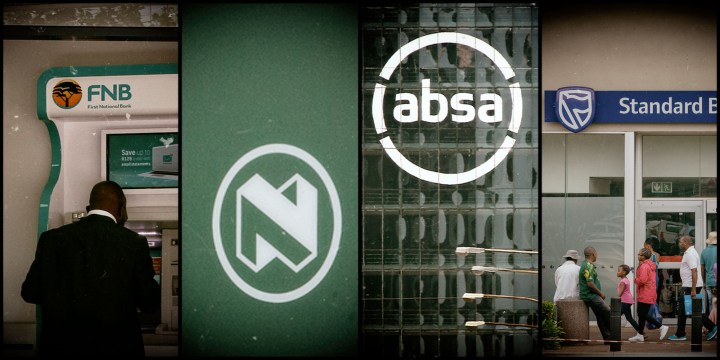BUSINESS MAVERICK
Bank results: what do they tell us?

Banks are in many ways a window into South Africa’s economy. If the economy performs, the banks will perform and vice versa. So what does the recent reporting season tell us about the past, and more importantly, the future?
Language, if you listen carefully, can reveal so much more than just the information carried in the words. And so, listening to the CEOs of three of South Africa’s big four banks, which alongside healthcare providers have stared down the jaws of the Covid-19 crisis, has been revealing.
By far the most conservative was Absa CEO Daniel Mminele who told investors that “this has been a crisis like no other”, one “whose impact will reverberate for years to come, with an uncertain recovery”.
Nedbank CEO Mike Brown struck a moderate tone, noting that “some [economic] improvement is expected later in the year”.
He guided for a 7% contraction in GDP, which is more optimistic than some analysts, who have pencilled in a number closer to 10%.
Standard Bank CEO Sim Tshabalala noted that “the world changed fundamentally and, to some extent, permanently, in a matter of weeks”.
A crisis like no other, as the Covid-19 pandemic has been, means that making sense of the interim results of three of the four big banks (FirstRand’s full year results are due on 10 September) is difficult, with many of the usual metrics distorted.
For instance, Absa reported headline earnings down 85% to R1.5-billion (normalised to account for the Barclays separation impact), Standard Bank down 44% to R7.5-billion and Nedbank down 69% to R2.1-billion.
Bad debt charges were similarly gruesome, with Absa reporting impairment charges of R14.7-billion, Standard Bank R11-billion and Nedbank R7.7-billion. In Absa’s case the impairments were four times the usual charge.
Aside from being truly awful numbers, what does this all mean? Are South Africa’s banks in trouble?
“On the contrary,” says Neill Young, a portfolio manager at Coronation Fund Managers. “They are showing significant declines in earnings and have suspended dividends as per the regulator’s request, but they are not showing losses and their capital positions are solid.”
A better (but not perfect) measure of performance, is to look at operating profit before provisions. Stripping out provisions is revealing.
Absa returned operating profit of R17.3-billion, up 7%, Standard Bank was up 4% at R24.2-billion, while Nedbank declined 7.9% to R10.7-billion.
The reason results are difficult to interpret is that bad debt and more specifically, provisions, have been the story of 2020.
When it comes to bad debts, new accounting standards, known as IFRS9, require banks to be forward-looking rather than backward-looking, which was the case during the global financial crisis.
This means they need to estimate today what they think future bad debts will look like, rather than making decisions based on past performance.
“To some extent, this requires the banks to exercise judgement,” says Stuart Theobald, chairman of research firm Intellidex. “They need to ask, how recoverable are bad debts going to be in an economy, unlike anything we’ve seen in the past?”
For example, in a healthy economy, if a bank client is retrenched chances of re-employment are good and making up missed payments is a better than even likelihood.
This cannot be assumed in a poor economy, where retrenchments are becoming the norm.
“Of course the banks will model for this, but their models are largely backwards-looking, and not up to the task. This is unprecedented and requires the banks to make judgement calls on the economy,” he says.
Again, the language the CEOs used when guiding for second-half performance was interesting.
Absa reported a hefty credit loss ratio (CLR) of 277 basis points (BPS). This is the cost of future write-downs, expressed as a percentage of the debtor’s book, and is charged to the income statement.
Management set aside R5.5-billion for future impairments and guided that it expected its CLR to improve “significantly”. This was included in the total credit loss charge (or bad debt expense) of R14.6-billion. This takes into account both current write-offs in the normal course of business, and anticipated future bad debts.
Standard Bank incurred a total impairment charge of R11.3-billion (or 169bps). This includes overlays of about R3.5-billion, of which R500-million sits at the centre – in other words, it hasn’t been specifically allocated to the divisions.
It is interesting to note that when it came to forward guidance, Standard Bank was the most reticent, saying only that “the outcome of the pandemic is by no means clear and further provisions may be required should the outlook deteriorate beyond our bear-case scenario”.
Nedbank reported a CLR of 194 BPS, which while not as hefty as Absa, is still almost triple that of previous reporting periods.
Management added R2.9-billion of credit impairment ‘overlays’ to bring total impairments to R7.7-billion.
Of all the banks, Nedbank gave the clearest guidance of what to expect in the second half.
“We think Nedbank has been quite brave,” says Theobald. “Impairments will remain the key outlook concern and Nedbank’s guidance to a full year CLR of 150 to 185 bps gives the market an anchor that has been missing.”
If banks are a window on to our economy, what they are clearly signalling is buckle up, because it’s going to be one hell of a ride. DM/BM



















 Become an Insider
Become an Insider